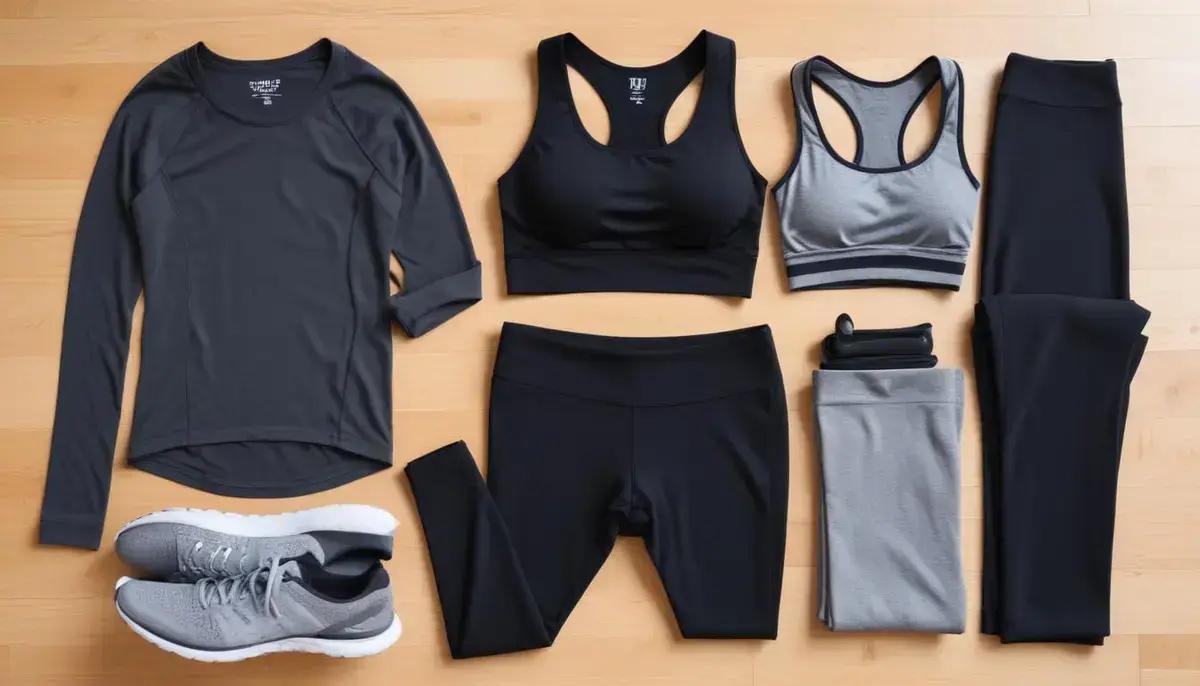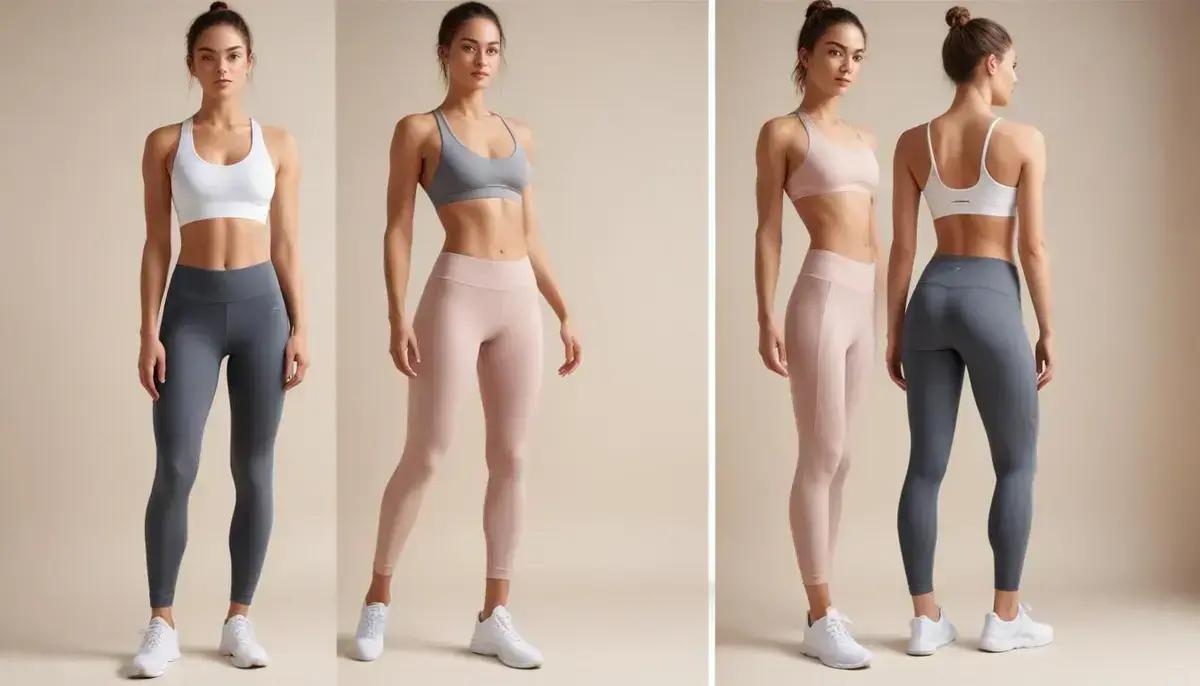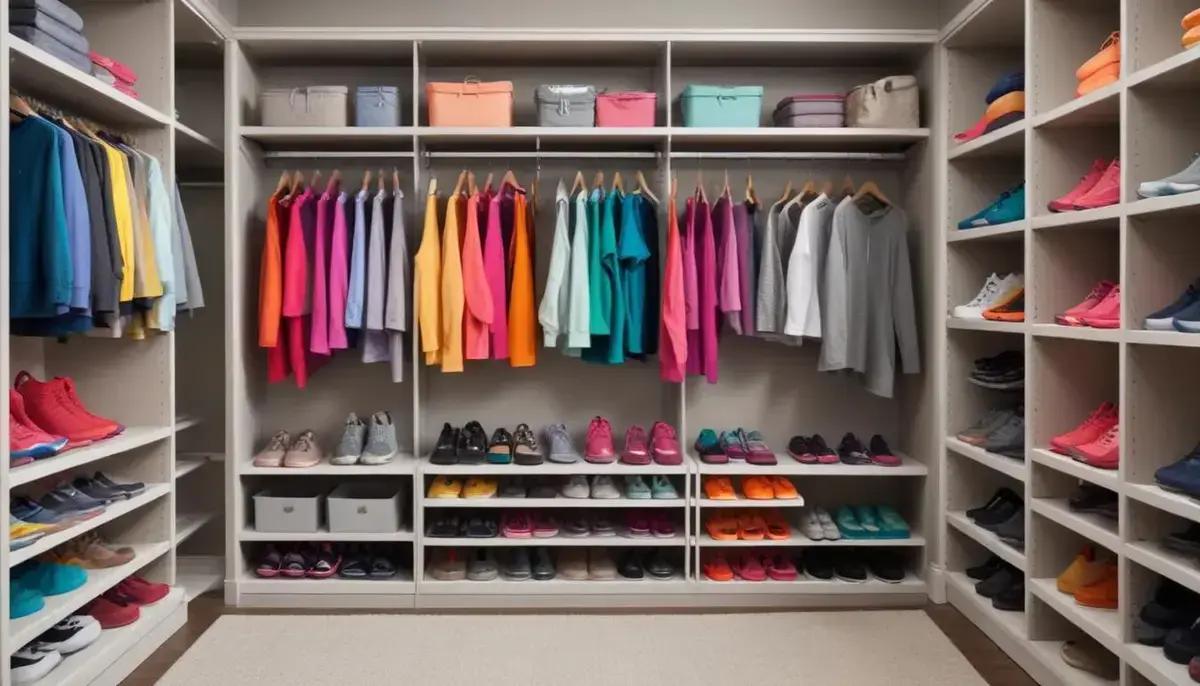Choosing the right gym clothes can make or break your workout experience. You know that feeling when your shirt rides up during burpees or your leggings become see-through mid-squat? The wrong athletic wear doesn’t just affect your performance – it can shake your confidence too.
Understanding fabric types and their benefits
Choosing the right fabric for your gym clothes can impact both comfort and performance. Not all materials are created equal—some wick away sweat better, while others provide more stretch or durability. Here’s what you need to know before picking your next workout outfit.
Moisture-Wicking Fabrics
Polyester and nylon blends are popular for their ability to pull sweat away from your skin, keeping you dry during intense workouts. These fabrics are lightweight and quick-drying, making them ideal for high-intensity training or hot yoga sessions.
Breathable Natural Fibers
Cotton might feel soft, but it absorbs sweat instead of wicking it away, leaving you feeling damp. However, blends with bamboo or merino wool offer natural breathability and odor resistance, perfect for low-impact activities or casual gym sessions.
Compression Fabrics
Spandex (or Lycra) is often blended with other fabrics to provide stretch and muscle support. Compression gear improves blood flow and reduces muscle fatigue, making it a favorite among runners and weightlifters.
Eco-Friendly Options
Recycled polyester and organic cotton are sustainable choices that don’t sacrifice performance. Brands are increasingly using these materials to reduce environmental impact while maintaining durability and comfort.
Remember, the best fabric depends on your workout. High-intensity sessions demand moisture control, while yoga or Pilates may prioritize flexibility. Always check the label—look for terms like ‘four-way stretch’ or ‘anti-microbial’ to match your needs.
Finding the right fit for your body type
Ill-fitting gym clothes can distract you from your workout and even affect performance. The right fit supports your body without restricting movement. Here’s how to find workout gear that complements your shape.
For Pear-Shaped Bodies
If you carry weight in your hips and thighs, look for leggings with a wide waistband for tummy control. Balance your proportions with fitted tops and darker colors on bottom. High-waisted styles provide extra support during squats and lunges.
For Apple-Shaped Bodies
Focus on tops with built-in bras that offer proper support without squeezing. Flowy tank tops camouflage the midsection while allowing airflow. Mid-rise leggings prevent uncomfortable rolling during cardio sessions.
For Athletic Builds
Compression shirts highlight toned physiques while wicking sweat. Look for leggings with strategic seaming to accentuate muscle definition. Avoid baggy clothes that hide your hard-earned shape.
For Tall Frames
Seek brands offering tall sizes to avoid ankle gaps in leggings. Longline sports bras provide extra coverage. Look for tops with extended torsos to prevent riding up during stretches.
For Petite Sizes
Cropped leggings eliminate excess fabric bunching. V-neck tops create the illusion of length. Avoid oversized patterns that can overwhelm a small frame.
Remember: Your gym clothes should move with you, not against you. Always do a squat test when trying on leggings and raise your arms when testing tops. Comfort should never be sacrificed for style.
Essential pieces every gym wardrobe needs

Building a functional gym wardrobe doesn’t require endless pieces – just these key essentials that work for nearly every workout. Invest in quality versions of these staples and you’ll always be prepared.
Performance Leggings
Look for squat-proof, high-waisted leggings with pockets. Dark colors hide sweat stains while four-way stretch allows full range of motion. One pair of compression leggings and one lightweight pair cover most needs.
Moisture-Wicking Tops
Three versatile tops: a fitted tank for weightlifting, a loose tee for cardio, and a long-sleeve for cooler days. Choose breathable fabrics with flat seams to prevent chafing during repetitive movements.
Supportive Sports Bra
Get professionally fitted for high-impact and medium-impact bras. Look for wide straps, encapsulated cups (not compression), and breathable back panels. This is one area where quality truly matters.
Cross-Training Shoes
Versatile shoes with lateral support for classes and moderate cushioning for treadmill work. Avoid running shoes for weight training – their soft soles compromise stability during lifts.
Gym Bag Must-Haves
Pack sweat-wicking socks, a microfiber towel, and a lightweight hoodie for post-workout. Include a separate wet bag for dirty clothes and always keep backup hair ties.
With these 5 core categories covered, you’ll have mix-and-match options for any workout. Remember: better to have a few excellent pieces than dozens of mediocre ones that don’t perform.
How to choose workout clothes for different activities
Your workout clothes should match your activity – what works for yoga might fail you during HIIT. Here’s how to dress smart for different exercise types to maximize performance and comfort.
Running & Cardio
Choose lightweight, breathable fabrics with reflective elements for outdoor safety. Compression shorts prevent chafing, while moisture-wicking socks protect against blisters. Look for tops with ventilation panels.
Weight Training
Opt for form-fitting clothes that won’t get caught in equipment. Knee sleeves provide support during squats, while grip socks enhance stability. Avoid loose shorts that might ride up during deadlifts.
Yoga & Pilates
Four-way stretch fabrics allow full range of motion. High-waisted leggings stay put during inversions, while seamless construction prevents mat burn. Barefoot shoes or sticky socks improve balance.
Cycling
Padded shorts reduce saddle discomfort, while aero-fit jerseys minimize wind resistance. Fingerless gloves improve grip, and arm warmers allow for temperature regulation during long rides.
Swimming
Chlorine-resistant fabrics maintain elasticity. Competitive swimmers need hydrodynamic suits, while casual swimmers should look for UV protection and quick-dry properties.
Remember: The right gear can enhance your workout while the wrong choice might hold you back. Always consider movement patterns, equipment interaction, and environmental factors when selecting activity-specific attire.
Color and style considerations for gym wear
While functionality comes first, the colors and styles of your gym wear can affect your workout experience and confidence. Smart choices can boost your mood and even improve performance.
Color Psychology in Workout Gear
Bright colors like red and orange increase energy levels for cardio, while cool blues and greens create calm for yoga. Dark colors are slimming and hide sweat, but can absorb heat in outdoor workouts.
Patterns and Prints
Vertical stripes create length, while color-blocking can accentuate or minimize areas. Small prints hide sweat better than large patterns. Camouflage prints are trending for both style and stain-hiding benefits.
Seasonal Color Transitions
Light colors reflect summer sun, while dark tones retain winter heat. Transition seasons call for layered looks with colorful base layers under neutral outerwear. Reflective elements are essential for low-light conditions.
Style Elements That Matter
Mesh panels add visual interest while improving ventilation. Contrast stitching highlights muscle definition. Strategic seam placement can create flattering silhouettes for all body types.
Building a Cohesive Gym Wardrobe
Start with neutral base pieces (black, gray, navy) that mix-and-match easily. Add 2-3 statement pieces in your power colors. Coordinate your shoes and accessories for a pulled-together look.
Remember: Your gym clothes should make you feel confident the moment you put them on. Choose colors that complement your skin tone and styles that reflect your personality – because when you look good, you often perform better.
Budget-friendly vs premium athletic wear options

When building your gym wardrobe, you’ll face the budget vs. quality dilemma. Understanding where to save and where to splurge can help you make smart choices without breaking the bank.
Where Budget Options Excel
Basic workout tees, simple leggings, and casual sports bras often perform nearly as well as premium versions for light to moderate exercise. Many affordable brands now offer moisture-wicking fabrics at fraction of the cost.
When to Invest in Premium
High-impact sports bras, running shoes, and compression gear often justify their higher price tags through superior engineering and durability. Premium brands typically offer better seam construction and more advanced fabric technologies.
Mid-Range Sweet Spots
Many mid-priced brands strike an excellent balance between quality and affordability. Look for sales on last season’s colors from reputable brands to get premium quality at reduced prices.
Cost-Per-Wear Calculation
Divide the item’s price by the number of times you’ll wear it. A $100 pair of leggings worn 200 times costs $0.50 per wear – often better value than $20 leggings that lose shape after 30 wears.
Smart Shopping Strategies
Outlet stores, seasonal sales, and bundle deals can make premium brands more accessible. Consider renting special occasion athletic wear (like triathlon gear) rather than buying.
Remember: The most expensive option isn’t always the best for your needs. Focus on finding pieces that offer the right combination of performance, comfort and durability for your specific workouts.
Caring for your gym clothes to extend their life
Proper care can double the lifespan of your gym clothes, saving you money and keeping them performing like new. Follow these expert tips to maintain your activewear’s quality and functionality.
Washing Do’s and Don’ts
Turn clothes inside out before washing to preserve colors and prints. Use cold water and mild detergent – hot water breaks down elastic fibers. Never use fabric softener as it coats technical fabrics, reducing their moisture-wicking abilities.
Drying Best Practices
Air drying is ideal – hang or lay flat to maintain shape. If using a dryer, choose low heat and remove promptly. High heat destroys elastane and can melt synthetic fibers over time.
Odor Elimination Techniques
Add 1/2 cup white vinegar to the rinse cycle monthly to remove stubborn odors. For quick refresh between washes, spritz with a mixture of water and vodka (1:1 ratio).
Storage Solutions
Store dry clothes in a cool, ventilated area – never leave damp gym clothes in a bag. Fold instead of hanging to prevent stretching. Use cedar balls instead of mothballs to deter pests naturally.
Special Fabric Care
Compression gear requires extra gentle handling. Swimwear needs immediate rinsing after chlorine exposure. Merino wool should be washed with specific wool detergents.
With proper care, quality activewear should maintain its performance for 2-3 years of regular use. Remember: Your gym clothes work hard for you – returning the favor with proper care pays off in the long run.
Common mistakes when buying workout clothes
Avoiding these common workout clothes shopping mistakes can save you money and frustration while ensuring your gym wear performs as expected during every sweat session.
Prioritizing Style Over Function
Many buyers choose clothes based solely on appearance, neglecting crucial factors like moisture-wicking capabilities and range of motion. That trendy crop top might look Instagram-worthy but could ride up during burpees.
Ignoring Fabric Composition
Failing to check labels leads to purchases of 100% cotton items that become sweat-soaked or blends that pill quickly. Look for technical fabrics with at least 15-20% elastane for optimal stretch and recovery.
Wrong Size Selection
Buying too tight restricts movement, while oversized clothes get in the way. Remember that activewear sizing often differs from casual clothing – always check brand-specific size charts and reviews.
Neglecting Activity-Specific Needs
Using running shorts for yoga or yoga pants for cycling leads to discomfort. Different workouts demand specific features like gussets, grip bands, or reinforced seams.
Impulse Buying Without Testing
Always do movement tests before purchasing – squat, lunge, and reach in dressing rooms. Online shoppers should order multiple sizes to test fit at home.
Smart shoppers consider their workout routine, body type, and fabric needs before purchasing. Remember: The right activewear should disappear on your body, letting you focus entirely on your workout.
Building a versatile gym wardrobe

Creating a versatile gym wardrobe means having the right pieces for any workout while minimizing clutter. Follow this strategic approach to build a functional collection that adapts to all your fitness needs.
Foundation Pieces
Start with 2-3 pairs of high-quality leggings or shorts in neutral colors (black, navy, gray) that match everything. Add basic tanks and tees in moisture-wicking fabrics – these form the backbone of your workout outfits.
Layer for Versatility
Include lightweight jackets, long-sleeve tops, and zip-up hoodies that can be added or removed as needed. Convertible pieces like reversible sports bras or pants with zip-off legs maximize options.
Activity-Specific Additions
Supplement your basics with specialized items: compression sleeves for running, grippy socks for yoga, or padded shorts for cycling. Choose these in colors that coordinate with your foundation pieces.
Seasonal Rotation
Store off-season items properly to extend their life. Summer clothes (light colors, breathable fabrics) can be swapped for winter pieces (thermal layers, darker tones) as temperatures change.
Accessory Essentials
Complete your wardrobe with sweat-wicking socks, supportive shoes for different activities, and a quality gym bag with compartments to keep everything organized.
With about 12-15 well-chosen items, you can create countless outfit combinations. Remember: A versatile gym wardrobe isn’t about quantity, but about selecting pieces that work hard for you across all your activities.
Your Perfect Gym Wardrobe Awaits
Choosing the right gym clothes makes a bigger difference than you might think. From fabric types to proper fit and activity-specific needs, every detail contributes to your comfort and performance.
Remember that quality often beats quantity when building your workout wardrobe. Invest in versatile basics first, then add specialized pieces as needed. With the right care, good activewear lasts through countless workouts.
Whether you’re just starting your fitness journey or upgrading your current gear, these tips will help you make smart choices. Your perfect workout outfit isn’t just about looking good – it’s about feeling confident and performing your best every time you exercise.
Now that you’re equipped with this knowledge, you’re ready to build a gym wardrobe that works as hard as you do!







